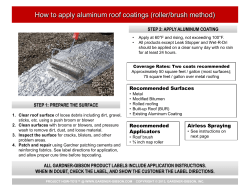
MCNP CLASS SERIES (MCNP GEOMETRY) Jongsoon Kim
MCNP CLASS SERIES (MCNP GEOMETRY) Jongsoon Kim Learning Objectives: Geometry Understand how to define all four classes of surfaces Understand how to create cells from surfaces Understand the detailed definition of macrobodies Geometry Basics The “universe” is divided into regions of different materials and properties The entire infinite universe must be included in geometric model The basic unit of a geometry is a “cell” All cells are defined by bounding surfaces All surfaces divide the universe into two regions Quick Start: Surfaces Equation surfaces Surfaces defined by providing the equation of the surface and the parameters (Table 3.1) Examples A sphere located at the origin with radius R j R A cylinder parallel to the y-axis at x, z with radius R j so c/y X Z R A plane normal to the z-axis at Z j pz Z Quick Start: Combining Surfaces into Cells Interior points of cell are related to a surface by the “sense” of the cell: ‘t’ or ‘-’ Surfaces divide universe into 2 half-regions Boolean operators Combine half-regions to create cells/objects Intersection Union Complement Quick Start: Combining Surfaces into Cells Sense All the points in a cell are related to the surfaces that define the cell by the sense – which side of a surface the points of a cell are on + (positive sense): For open surfaces (planes), points in positive direction from surface For closed surfaces (spheres, cylinders, etc), outside the surface - (negative sense): For open surfaces, points in negative direction from surface For closed surfaces, inside the surface Quick Start: Combining Surfaces into Cells Intersection Space where both senses are true Input syntax: a <space> between two surface numbers 2_-1represents only the region of space with sense +2 and sense -1 Quick Start: Combining Surfaces into Cells Union Space where either sense is true Input syntax: a <colon> ‘:” between two surface numbers 2:-1 represents both the region of space with sense +2 and the region with sense -1 Quick Start: Combining Surfaces into Cells Complement Space outside another cell Input syntax: a <pound symbol> ‘#’ before a cell number #5 represents the region outside cell 5 This region can then be intersected or united with other regions -2 #5 represents the only the region outside cell 5 and inside surface 2 Four Classes of MCNP Surfaces: Analytic Equations Analytic equations Planes, Spheres, Cylinders, Cones, Tori, Arbitrary Quadratics Four Classes of MCNP Surfaces: Macrobodies Combinatorial geometry based on closed primitives Surfaces of finite “building blocks” BOX: arbitrarily oriented orthogonal box RPP: rectangular parallelepiped All surfaces normal to respective axes SPH: Identical to “equation” for sphere RCC: sphere right circular cylinder Axis orthogonal to base, but arbitrarily oriented Four Classes of MCNP Surfaces: Axisymmetric sets of points Planes & Linear or Quadratic surfaces Example 1: j Z 7 5 3 2 4 3 A surface sysmmetric about z-axis, which passes through the three (z,r) points, (7,5), (3,2), and 4,3) Four Classes of MCNP Surfaces: Three point in a plane General Planes Form: j P X1 Y1 Z1 X2 Y2 Z2 X3 Y3 Z3 Coordinates of three points lying in the desired plane Convert them to the required surface coefficient to produce plane Ax + By + Cz – D = 0 Coordinate Transformation TRn Data Card (see page 3-31) TRn Ox Oy Oz Bxx’ Byx’ Bzx’ Bxy’ Byy’ Bzy’ Bxz’ Byz’ Bzz’ n Number of transformation Ox Oy Oz Displacement vector of the transformation Bxx’ . . . Bzz’ Rotation matrix of the transformation Angles in degrees when *TRn card is used, otherwise in cosines Example of Coordinate Transform (CCW 67.5 for apple simulation for 1.35 MeV electron beam irradiation) o Z Y Z Y xx’ yx’ zx’ xy’ yy’ *TR1 0 0 0 0 90 90 zy’ xz’ yz’ zz’ 90 67.5 22.5 90 157.5 67.5 Homework Think about your geometry for term project and make cell and surface cards
© Copyright 2025





















